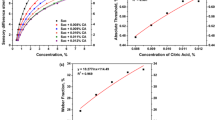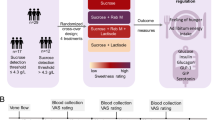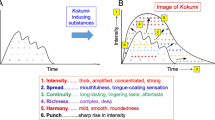Abstract
THE mechanism of taste perception has been approached through work on the relationships between chemical properties of taste stimuli and their resultant taste responses. Ferguson and Lawrence1,2 reported that the D-configurations of leucine, iso-leucine, valine, histidine, tryptophan and asparagine were sweet, whereas the L-forms were not. These authors observed that isomaltose (6-α-D-glucopyranosyl-D-glucose) was sweet, but its anomer, gentiobiose (6 - β - D - glucopyranosyl - D - glucose), was bitter. Cameron3,4 found that a freshly prepared solution of 10 per cent α-D-glucose was definitely sweeter than a 16-hr.-old 10 per cent solution. The magnitude of the response (fourteen evaluations) suggested that the fresh solution had a sweetness equal to or more than that of a 10.5 per cent equilibrium solution.
This is a preview of subscription content, access via your institution
Access options
Subscribe to this journal
Receive 51 print issues and online access
$199.00 per year
only $3.90 per issue
Buy this article
- Purchase on Springer Link
- Instant access to full article PDF
Prices may be subject to local taxes which are calculated during checkout
Similar content being viewed by others
References
Ferguson, L. N., and Lawrence, A. R., J. Chem. Ed., 35, 435 (1958).
Lawrence, A. R., and Ferguson, L. N., Nature, 183, 1469 (1959).
Cameron, A. T., Trans. Roy. Soc. Canad., 37, 11 (1943).
Cameron, A. T., Sci. Rep. No. 9, 44 (Sugar Research Found., Inc., New York, 1947).
Roessler, E. G., Baker, G. A., and Amerine, M. A., Food Research, 21, 117 (1956).
Rogers's Associates, Fundamentals of Dairy Science, 130, second ed. (Reinhold, 1935).
Hodgman, C. D., et al., Handbook of Chemistry and Physics, 947, thirty-eighth ed.
Jenness, R., and Patton, S., Principles of Dairy Chemistry, 78 (John Wiley, 1959).
Dethier, V. G., Quart. Rev. Biol., 30, 348 (1955).
Stoll, M., Molecular Structure and Organoleptic Quality, S.C.1, 5 (Monograph No. 1, London, 1957).
Baradi, A. F., and Bourne, G. H., Science, 113, 660 (1951).
Baradi, A. F., and Bourne, G. H., Nature, 168, 977 (1951).
Author information
Authors and Affiliations
Rights and permissions
About this article
Cite this article
PANGBORN, R., GEE, S. Relative Sweetness of α- and β-Forms of Selected Sugars. Nature 191, 810–811 (1961). https://doi.org/10.1038/191810a0
Issue Date:
DOI: https://doi.org/10.1038/191810a0
This article is cited by
-
Role of the anomeric centre in sugar sweetness
Experientia (1986)
Comments
By submitting a comment you agree to abide by our Terms and Community Guidelines. If you find something abusive or that does not comply with our terms or guidelines please flag it as inappropriate.



